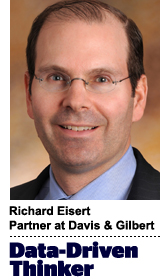 “Data-Driven Thinking” is written by members of the media community and contains fresh ideas on the digital revolution in media.
“Data-Driven Thinking” is written by members of the media community and contains fresh ideas on the digital revolution in media.
Today’s column is written by Richard Eisert, partner at Davis & Gilbert.
The increasing prevalence of bots and other automated systems on the internet has roiled the digital ad industry over the past few years, most notably through their association with fraudulent traffic and ad views.
But brands are starting to flip the script by using bots and artificial intelligence (AI) for their own benefit. Notably, some brands are capitalizing on the growing influencer market by creating or engaging with “virtual” or “AI” influencers.
These influencers are not real people, but they exist online or in other digital environments and interact with consumers in much the same way as traditional influencers. In fact, sometimes it is hard to tell the difference between a virtual influencer and a real one.
AI influencers are already representing top brands
Perhaps the most prominent virtual influencer is Lil Miquela, aka Miquela Sousa, a computer-generated model and music artist with more than 1 million followers on Instagram. Lil Miquela has an age, location, ethnicity and acts like any other influencer. She takes selfies, has a boyfriend, interacts with followers, writes emotive captions and – yes – promotes third-party brands.
The popularity of virtual influencers such as Lil Miquela reflects a broader trend in marketing that blurs the line between what is real and virtual. For example, Coca-Cola recently signed an endorsement deal with virtual athlete Alex Hunter, a fully customizable character in EA Sports’ FIFA video games.
Earlier this year, Fenty Beauty featured a virtual model on its Instagram page. And last year, Chevrolet released “The Human Race,” a collaboration with Epic Games that featured a race between a human driver and an AI-powered vehicle.
Each of these examples shows an increasing desire among brands across a wide scope of industries to incorporate virtual and artificial personalities into their marketing campaigns.
Legal and PR challenges
Have brands adequately considered the risks of using virtual influencers?
Theoretically, virtual influencers could offer many benefits to brands and agencies. First, if the advertiser creates and directs the influencer, then it presumably has a certain degree of control over what the influencer does and says. In that sense, brands can create their ideal influencer – one that connects directly with their desired demographic and acts within the bounds of the brand’s legal guidelines.
Similarly, brand safety and bad PR are seemingly a lesser concern with virtual influencers, since the influencers can be programmed to not discuss certain matters, use certain words or reference third-party brands. All of this assumes, of course, that the advertiser can control and direct the influencer, which may not always be the case, such as when third-party virtual influencers are “hired” by brands, much like a traditional influencer, or when the AI that powers a virtual influencer is given relatively free rein.
If virtual influencers cannot always be directed and controlled, what happens when one crosses the line in the real world? While the public may or may not be more understanding when the virtual influencer manages to offend or even mislead real people, it is – unfortunately for brands – unlikely that any kind of new “virtual influencer” defense will stand up when legal boundaries are crossed, at least as far as the Federal Trade Commission (FTC) is concerned.
We know the FTC has been actively enforcing influencer disclosure obligations, so any virtual influencer would need to understand – or be programmed to understand – when such disclosures were necessary and be able to make them adequately.
The FTC further states that advertisers and agencies have a duty to monitor influencers and third-party influencer platforms to ensure compliance with legal obligations. In all likelihood, this duty extends to influencers, both real and virtual. That requirement is especially relevant to virtual influencers given the number of unknowns surrounding them.
Navigating the unknown
Despite the concerns – whether the concerns are purely legal in nature or broader, like PR and brand safety – the risks of engaging virtual influencers can be somewhat mitigated by obtaining strong brand safety and morals clauses and robust representations, warranties and indemnity obligations in contracts with influencer platforms (or from the influencer technology partner if the brand develops its own virtual influencer).
Careful consideration of risks from the outset and diligent monitoring after launch of a campaign, including termination of influencers who engage in improper conduct, are also essential to lessen risks and have been considered important factors by the FTC.
While the FTC has yet to weigh in on virtual influencers, and we don’t know how much scrutiny it will apply in this area, brands need to proceed with caution, applying at least the same level of careful monitoring and contractual controls they would apply to real-world influencers.
The tantalizing potential of virtual influencers cannot be ignored. But marketers should not turn a blind eye to the risks.
Follow Davis & Gilbert (@dglaw) and AdExchanger (@adexchanger) on Twitter.
This post was syndicated from Ad Exchanger.

More Stories
Marketing Morsels: Hidden Valley Ranch, La-Z-Boy, Topps & More
Flashback: Jane Pauley and Deborah Norville Revisit Today’s 1989 Succession Drama
Ally Financial Revives ‘Banksgiving’ With A TikTok Twist